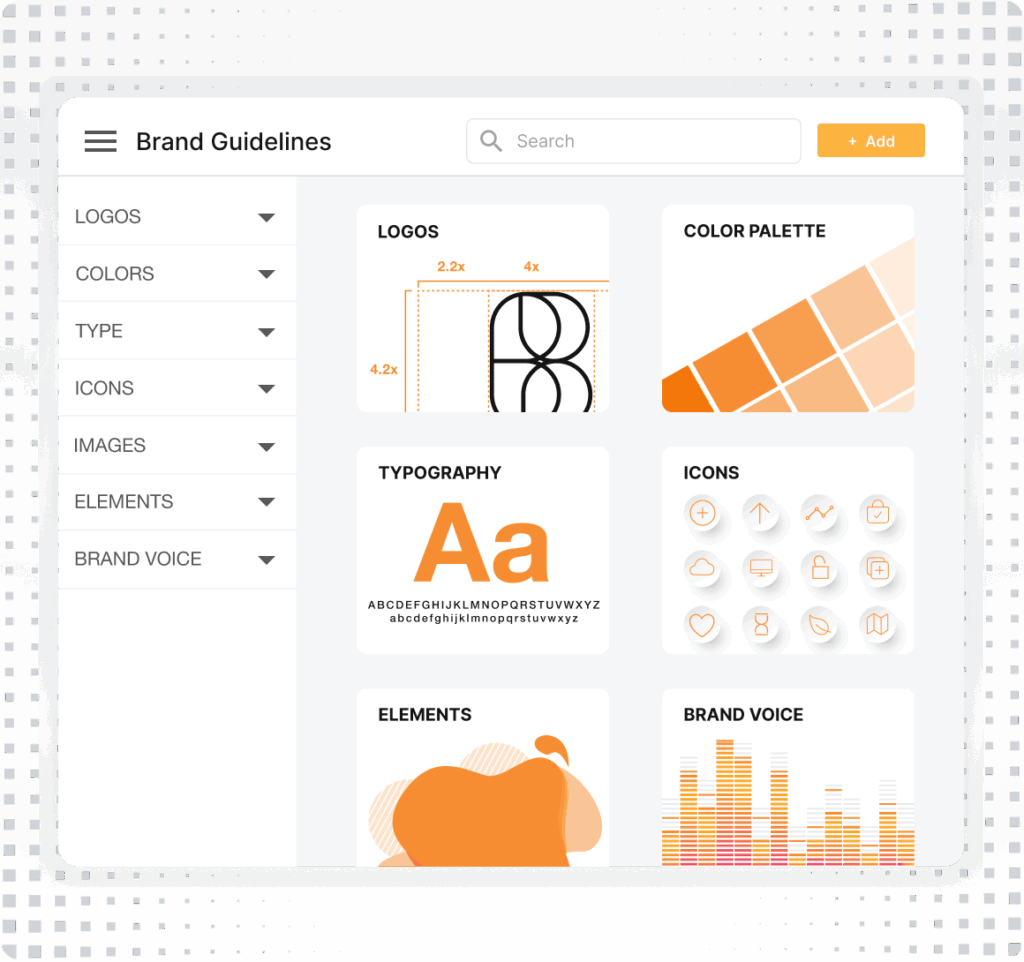In an ideal world, managing brand consistency across a franchise would be as straightforward as managing it for an independent brand. After all, smaller teams and fewer variations mean fewer opportunities for mishaps.
Realistically, managing multiple teams across an entire franchise network in diverse locations tends to complicate things. And without an accessible and practical way to create and enforce franchise brand guidelines, the consequences of a fragmented image tend to escalate as well.
And yet, it’s not unusual for inconsistencies and blind spots to crop up — especially as a franchise scales. The key to keeping brand identity intact is to establish a central approach to managing brand guidelines across franchisees.
In this article, we’ll explore how to maintain consistency as you grow and how scalable brand management solutions can protect brand equity.

Why Franchise Brand Guidelines Matter
Franchise brand guidelines are a set of rules that specify how your brand should look, sound, and show up — no matter where it’s being represented. They help every franchisee stay on the same page, whether they’re running social posts in one location or designing branded print media in another.
When brand elements like tone, colors, and messaging are used consistently, a brand becomes instantly recognizable and easier for people to connect with. In turn, this consistency builds trust. It strengthens brand equity, enhances marketing efficiency, and supports stronger profitability over time.
When all franchisees align as a cohesive whole, the entire network benefits. In theory, it doesn’t sound overly complicated. But the real world can present twists and turns. Let’s take a look at how that can play out:
Effective franchise brand guideline management in action
CKE Restaurants Holdings, Inc. (CKE) is a privately held company in Franklin, Tennessee, that runs and operates Carl’s Jr. and Hardee’s. With a U.S.-based and international footprint, Carl’s Jr. Restaurants and Hardee’s Restaurants have over 3,900 franchised or company-operated restaurants in 44 states and 42 countries.
The company worked with several third-party agencies to handle advertising and creative initiatives, which included managing digital marketing assets. However, CKE lacked a central point for teams to access marketing collateral. As a result, the marketing team became inundated with content requests.
To uphold the brand’s reliability and integrity, while implementing a scalable solution for franchises to access on-brand, up-to-date marketing collateral, CKE needed:
- Autonomy for every franchise
- Organized assets
- Seamless sharing and distribution
- Accessible brand guidelines
- Consistent branding
- Insights and analytics
CKE opted for a digital asset management system and brand portal to find and use approved branded content, supported by advanced metadata, automated keyword tagging, and intuitive search capabilities.
Simplified digital content sharing facilitated collaboration between internal and external teams. It also minimized the risk of local restaurants using unapproved designs or inconsistent marketing campaigns.
So, what does it take to build franchise brand consistency at this scale?
Building Franchise Brand Guidelines: 6 Best Practices

Creating a successful franchise brand hinges on maintaining a strong brand identity across each franchise business. Below, we outline the strategies and brand management tools to help you get there:
1. Include these key components of franchise brand guidelines
A comprehensive set of brand guidelines should include:
- Logo guidelines: This encompasses rules for logo usage, sizing, spacing, and common mistakes to avoid. Make approved logos available for instant download.
- Brand colors: Clearly outline your full color system, including primary palettes, gradients, and specific usage guidelines for each.
- Brand typography: Guidelines specify which fonts to use and how to apply them in various contexts, with approved fonts readily available for download.
- Consistent iconography: Provide instructions for using your brand’s specific icon style, ensuring visual alignment across all channels. It helps to keep brand icons available for quick downloads as well.
- Messaging frameworks: Outline the tone and style of the conversations you’re having with consumers through marketing collateral, ensuring your voice remains consistently on-brand.
- Approved visuals: Include approved images that represent your brand’s style. Throw in some examples for inspiration.
- Creative templates: Ready-to-use, customizable templates empower franchisees to create locally relevant marketing materials while staying on-brand. These templates are pre-designed for social media, print ads, email campaigns, and allow for easy edits (such as contact details, local pricing, and tailored copy) without compromising brand integrity.
- Additional assets: Beyond these elements, brand guidelines often provide access to other approved brand assets such as videos and illustrations and even instruction on how to facilitate self-service for internal teams and external agencies.
In a franchise environment, it’s not enough to create a fresh set of brand guidelines, then hand them out to your franchise network. You’ll also need to consider how to manage and enforce your guidelines to achieve a cohesive brand identity at scale.
2. Keep brand guidelines consistent across multiple locations
Without a central location to store your branding guidelines, making even minor tweaks as your franchise brand scales creates a lot of work and introduces risk. A brand portal is a system that maintains consistent, up-to-date, and easy-to-manage brand guidelines across multiple locations.
Housing your brand guidelines and assets in a centralized hub ensures teams and agencies have 24/7 access to the most current brand guidelines and assets anywhere in the world. By providing clear rules for brand collateral and image usage, the portal ensures visuals stay aligned across every channel and teams maintain consistent usage across a global franchise network.
3. Maintaining asset control
In a franchise marketing strategy, implementing practical brand guidelines and maintaining oversight of assets are two sides of the same coin. If the guidelines are the eyes that determine how marketing collateral should look, asset management is the brain that makes it possible across your franchise system.
A digital asset management (DAM) system integrates seamlessly with your brand portal, making it easy for a franchise business to self-serve the most up-to-date, approved brand assets, regardless of location. Teams can easily store, search, and share creative assets with AI-generated metadata tags and intelligent search capabilities.
Beyond organization, a DAM system also enables you to control which assets people can and can’t access, making certain files or pages available to individuals, groups, or roles. This helps maintain full control over digital assets — including distribution and usage — while ensuring all marketing collateral adheres to brand standards.
4. Implement the franchisee brand guidelines
Deploying your brand guidelines means ensuring they’re accessible and understood by all stakeholders who need to use them. Of course, staff, agencies, and partners’ needs and applications will vary. So, with that in mind, here are some ideas to make the process smoother.
Aim for customizable access: Personalize the experience for different users, ensuring they have access to what they need. For instance, this could involve creating a custom brand portal for each franchisee, tailored to their specific marketing workflows.
Empowering self-service: Provide franchisees with instant access to all necessary brand assets. This allows teams to find everything they need directly, reducing low-value tasks for central marketing teams.
Offer clear and engaging guidance: Make viewing brand guidelines an engaging experience with intuitive navigation, video, and real examples of your brand in action. That way, franchisees clearly understand how to use their brand assets and guidelines effectively to represent the brand.
5. Ensure Training for franchises
Within a franchise network, the reality is that most franchise owners will come from a variety of professional backgrounds and, in many cases, won’t have any prior marketing experience. It’s the franchisor’s role to bring franchisees up to the necessary level of competence and skill through tailored training.
- Lead with the “why”
Start by helping potential franchisees understand the stakes. When they get that brand consistency isn’t just about fonts and colors — but also about trust, credibility, and local brand loyalty — they’re far more likely to start out on the right foot. Give real-world examples of how strong branding drives business results. - Bake branding into onboarding
Don’t treat brand training like an optional extra. Integrate it into the early days of onboarding so franchisees know from the jump that it’s a non-negotiable part of doing business. Make it easy, visual, and relevant to their daily operations. - Make it a two-way street
Encourage questions, feedback, and even suggestions. Franchisees are closer to the customer than HQ — if they’re flagging gaps or friction in applying brand assets, listen. It shows respect and keeps the brand practical and adaptable. - Anticipate and prepare for challenges
The best way to curb common challenges associated with implementing new franchise brand guidelines is to prepare. Remember that inconsistencies can pop up. The best way to combat them is to utilize reporting systems to monitor activities such as asset usage and downloads, catching any issues early.
Within an endorsed brand structure, a mishap from one franchisee can impact the entire chain. Strong, open lines of communication foster trust and alignment within your network. At the same time, dynamic brand management tools provide the clarity and oversight necessary to strategically manage branding efforts as the franchise expands.
Create and Implement Franchise Brand Guidelines at Scale
For franchises, scaling a branded content isn’t just about growth, it’s about maintaining consistency at every level. Without centralized control, local adaptations can dilute your brand’s identity, fragment customer experience, and weaken marketing ROI. The right brand guidelines, when paired with scalable tools, ensure uniformity while empowering franchisees to execute campaigns efficiently, no matter how large your network grows.
IntelligenceBank’s brand management solutions support franchises in achieving consistent and efficient marketing at scale. Connect with our team to explore how we can help you manage effective franchise branding as you grow.




